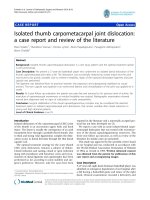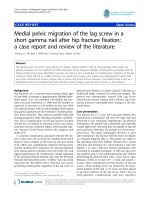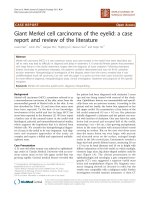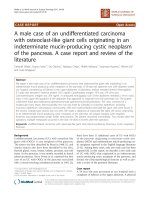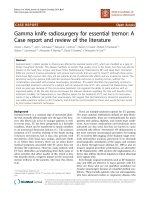Báo cáo khoa học: "Post-radiation sciatic neuropathy: a case report and review of the literature" pot
Bạn đang xem bản rút gọn của tài liệu. Xem và tải ngay bản đầy đủ của tài liệu tại đây (514.56 KB, 5 trang )
BioMed Central
Page 1 of 5
(page number not for citation purposes)
World Journal of Surgical Oncology
Open Access
Case report
Post-radiation sciatic neuropathy: a case report and review of the
literature
Panagiotis D Gikas*
1
, Sammy A Hanna
1
, Will Aston
2
, Nicholas S Kalson
3
,
Roberto Tirabosco
4
, Asif Saifuddin
5
and Steve R Cannon
1
Address:
1
Bone Tumour Unit, Royal National Orthopaedics Hospital, Stanmore, Middlesex, HA7 4LP, UK,
2
Oncology and Arthroplasty Fellow,
Royal Prince Alfred Hospital, Camperdown, Sydney, Australia,
3
The Medical School, University of Manchester, Oxford Road, Manchester, M13
9PT, UK,
4
Department of Pathology, Royal National Orthopaedics Hospital, Stanmore, Middlesex, HA7 4LP, UK and
5
Department of Radiology,
Royal National Orthopaedics Hospital, Stanmore, Middlesex, HA7 4LP, UK
Email: Panagiotis D Gikas* - ; Sammy A Hanna - ;
Will Aston - ; Nicholas S Kalson - ;
Roberto Tirabosco - ; Asif Saifuddin - ; Steve R Cannon -
* Corresponding author
Abstract
Background: Post-radiation peripheral neuropathy has been reported in brachial and cervical
plexuses and the femoral nerve.
Case presentation: We describe a patient who developed post-radiation sciatic neuropathy after
approximately 3 years and discuss the pathophysiology, clinical course and treatment options
available for the deleterious effects of radiation to peripheral nerves.
Conclusion: This is the first case of post-radiation involvement of the sciatic nerve reported in
the literature.
Background
Post-radiation neuropathy was first reported in patients
treated with radiotherapy to the axillary glands for malig-
nant breast tumours. It has also been reported in patients
treated for malignant lesions in the faciomaxillary region,
where the cervical plexus, facial or hypoglossal nerves
have been involved. Furthermore, two case reports exist in
the literature of post-radiation femoral neuropathy [1,2].
To our knowledge, there has been no description so far of
post-radiation involvement of the sciatic nerve.
In this article, we describe the case of a patient who devel-
oped post-radiation sciatic neuropathy after approxi-
mately 3 years and discuss the pathophysiology, clinical
course and treatment options available for the deleterious
effects of radiation to peripheral nerves.
Case presentation
A 22 year-old media student presented in 2001 with a
two-year history of a mass in her left thigh adductor com-
partment. Magnetic resonance imaging (MRI) demon-
strated a poorly defined, lobular mass in the left proximal
adductor compartment, with significant areas of signal
void consistent with the presence of excessive fibrous tis-
sue (Figure 1). Needle biopsy confirmed a diagnosis of
musculo-aponeurotic fibromatosis (Figure 2). The lesion
was subsequently excised by complete adductor compart-
ment resection with the exception of adductor longus.
Published: 11 December 2008
World Journal of Surgical Oncology 2008, 6:130 doi:10.1186/1477-7819-6-130
Received: 10 October 2008
Accepted: 11 December 2008
This article is available from: />© 2008 Gikas et al; licensee BioMed Central Ltd.
This is an Open Access article distributed under the terms of the Creative Commons Attribution License ( />),
which permits unrestricted use, distribution, and reproduction in any medium, provided the original work is properly cited.
World Journal of Surgical Oncology 2008, 6:130 />Page 2 of 5
(page number not for citation purposes)
MRI of the left thighFigure 1
MRI of the left thigh. Axial T1W SE (a) and coronal STIR (b) images showing a poorly defined, lobular mass in the left adduc-
tor compartment (arrows) showing extensive areas of signal void due to fibrous tissue. Note the location of the sciatic nerve
(arrowhead).
Typical microsopic features of musculoaponeurotic fibromatosisFigure 2
Typical microsopic features of musculoaponeurotic fibromatosis. Interlacing bundles of uniform spindle-shaped cells
with pale oval nuclei and eosinophilic cytoplasm; there is a prominent collagen stroma.
World Journal of Surgical Oncology 2008, 6:130 />Page 3 of 5
(page number not for citation purposes)
Post-operatively the patient completed a course of radio-
therapy, receiving a total dose of 50 Gy in 25 fractions
over five weeks.
Towards the end of 2002, she developed a swelling in the
postero-medial thigh, distal to the previous irradiation
field. MRI confirmed recurrence just above the level of the
femoral condyles. In December 2002, she underwent fur-
ther resection followed by a further course of radiotherapy
(30 Gy in 15 fractions over 4 weeks) with an inch overlap
with the previous radiation field superiorly.
In June 2003, the patient developed a further proximal
thigh recurrence in the previously surgically treated area,
within the initial radiotherapy field. She was started on
Tamoxifen and further excision performed.
In March 2004, she started complaining of progressive
weakness of dorsiflexion of her left foot, associated with
pain around the medial aspect of the foot and sole. On
clinical examination, she had normal hip flexion/exten-
sion and abduction with almost absent adduction, and
normal knee flexion and extension. Foot flexion and
inversion was 4/5. Foot and toe extension and eversion
were 2/5. The ankle tendon reflex was absent. There was
normal sensation on the anterior and posterior aspects of
her thigh indicating that the posterior cutaneous nerve of
the thigh coming from the sacral plexus was intact and
hence that any lesion was distal to the sacral plexus. She
had almost no sensation in the sole of her foot with
reduced perception of touch on the dorsum of her foot.
When palpating along the course of the sciatic nerve a
rather dense region of local scarring was present on the
posterior aspect of the thigh approximately 10 cm from
the knee.
Electrophysiological assessment indicated a non localiz-
ing sciatic nerve sciatic nerve injury. Based on the clinical
findings and investigations, a diagnosis of radiation-
induced injury to the sciatic nerve was made, affecting the
common peroneal portion more that the tibial portion.
Repeat MRI of the left thigh demonstrated a seroma in the
left groin and diffuse oedema and swelling of the left sci-
atic nerve (Figure 3). A decision to perform neurolysis of
the sciatic nerve was made, with a view to freeing the nerve
from any associated scar tissue, thereby halting any fur-
ther deterioration in function.
At the most recent follow up in 2008, the patient is free
from recurrence. There has been no further deterioration
in sciatic nerve function but weakness of foot dorsiflexion
persists, necessitating use of a splint.
Follow up MRI of the thighFigure 3
Follow up MRI of the thigh. Coronal STIR (a) and axial fat suppressed T2W FSE (b) images showing diffuse swelling and
oedema of the sciatic nerve (arrows) and a postoperative seroma in the groin (arrowhead).
World Journal of Surgical Oncology 2008, 6:130 />Page 4 of 5
(page number not for citation purposes)
Discussion
Pathophysiology and clinical course
Very little is known about the pathophysiology and the
histopathological changes that occur in peripheral nerves
after therapeutic irradiation. Early experimental studies
indicated that the peripheral nerves are extremely radiore-
sistant. However, the follow up time was short and it is
likely that the injury did not have an opportunity to
develop [3].
Today we know that post-irradiation neuropathy occurs
both directly and indirectly: directly by the harmful effect
of the radiation on the nerve itself, and indirectly by the
fibrosis that radiation causes in the tissue around the
nerve [2].
Direct effects of irradiation on nerve include bioelectrical
alterations (subnormal action potentials, altered conduc-
tion time), enzyme changes, abnormal microtubule
assembly, altered vascular permeability and neurilemmal
damage. All of these changes are observed experimentally
within 2 days after irradiation and are all dose dependent
and irreversible [4-6].
The secondary damage to the nerve is due to the extensive
fibrosis of the connective tissue around the nerve, which
becomes densely hyalinised. There is also a progressive
loss of elasticity and the development of contractures that
ultimately consolidate the adjacent structures with the
nerve. In addition, the decreased vascularity of the area
may destroy some adjacent peripheral nerves. Regenera-
tion of the affected nerves may be impeded [2]. In a report
of findings at autopsy in two patients who had post-irra-
diation brachial-plexus syndrome [7], varying degrees of
fibrosis of the neurilemma, as well as demyelinization
and fibrous replacement of the fibrils, were described.
Mendes et al. in histological examination of femoral nerve
branches removed during surgical decompression of the
femoral nerve, in a patient with post-irradiation femoral
neuropathy, also found demyelinated nerve fibres sur-
rounded by abundant scar tissue with areas of hyaliniza-
tion [2].
Peripheral nerve damage is a rare but understandably
major complication of radiation therapy associated with
significant morbidity. The frequency of injury reported
from some of the older studies is probably higher than
would occur today as prior to the advent of CT and MRI,
larger fields were used because of greater uncertainty
about the dimensions of the tumour.
In studies looking into post-irradiation neuropathy
involving the brachial and cervical plexuses after radio-
therapy for breast carcinoma it was found that symptoms
generally begin within one to two years after treatment
and are initially mainly sensory (e.g. burning pain, numb-
ness, paresthesia) [7,8]. Any motor deficits that develop
are usually delayed for about eighteen months and
include paresis of a group of muscles and complete paral-
ysis of the arm [9]. Stoll et al. and Powell et al. have both
found a direct relationship between the dosage of radia-
tion and the severity/time of appearance of symptoms
[7,10].
In a review of radiation injury to peripheral nerves pub-
lished by Giese and Kinsella the authors conclude that
peripheral neuropathy is relatively infrequent at lower
doses per fraction [11]. They expressed concern that co-
factors such as radiosensitizers, chemotherapeutic agents
and surgical manipulations could possibly increase the
incidence. Breast cancer patients receiving cytotoxic chem-
otherapy had a higher incidence of radiation induced bra-
chial plexopathy compared to those having radiation only
following mastectomy [12].
Any peripheral nerve may be affected by post-radiation
neuropathy and it is likely that the unique location of this
tumour reflects 1) the special site of radiation therapy and
2) the repeated doses of radiation administered [12].
Latency is an important factor to be considered when eval-
uating nerve injury [12]. Stoll and Andrews did not
observe any neuropathy occurring before 5 months, with
a majority occurring between 10 and 22 months after irra-
diation. They also noted that the higher dose group did
show signs earlier than the lower dose group. Powell et al.
did not observe any nerve injury prior to 10 months post-
irradiation, whereas reports exist in the literature of neu-
ropathies occurring as late as 11 years after irradiation for
breast cancer. Therefore, latency, as our case demon-
strates, is a very important factor to be considered, since
short follow-up times may underestimate the true inci-
dence of post-irradiation injury to peripheral nerves.
Management
When considering management of post-irradiation
peripheral neuropathy, it is important to realise that an
unalterable condition is the status of the patient's under-
lying malignancy prior to initiation of treatment, includ-
ing tumour size, location and structures involved/
destroyed [12]. Furthermore, release of entrapped nerves
from a fibrous mass can be challenging even for the most
skilled surgeon. Therefore, a short life expectancy coupled
with uncertainty of recovery from surgical intervention
make conservative management more appropriate.
Also important in overall response to and recovery from
therapy is the general health of the patient and, if a child,
the stage of development and growth [12]. If surgery is a
part of the overall treatment, as was in our case, then the
Publish with Bio Med Central and every
scientist can read your work free of charge
"BioMed Central will be the most significant development for
disseminating the results of biomedical research in our lifetime."
Sir Paul Nurse, Cancer Research UK
Your research papers will be:
available free of charge to the entire biomedical community
peer reviewed and published immediately upon acceptance
cited in PubMed and archived on PubMed Central
yours — you keep the copyright
Submit your manuscript here:
/>BioMedcentral
World Journal of Surgical Oncology 2008, 6:130 />Page 5 of 5
(page number not for citation purposes)
extent of the surgical resection and the techniques used
are also of major importance to post-therapy function. In
addition, the long-term soft tissue response to radiation is
a complex function of many radiation related factors
(total dose, dose volume and distribution, fraction size,
dose rate, treatment interval and overall treatment time)
some of which are poorly understood. Important non-
radiation factors that play a role in influencing the devel-
opment, progression and response to treatment of post-
radiation neuropathy, include other therapies such as sur-
gery and chemotherapy, major organ system perform-
ance, overall activity level and chronic conditions such as
hypertension, diabetes and connective tissue disorders.
In patients who have a good life expectancy after tumour
excision, an increasing motor deficit and/or intolerable
pain in the distribution of a peripheral nerve may present
some years after the initial treatment. Some patients may
require surgical release of the radiation induced scar tissue
surrounding the nerve. However, the patient has to be
aware of the uncertainty of recovery.
When a decision has been made to pursue a surgical path,
treatment should not be delayed as research has shown
that pathological changes in a peripheral nerve restricted
by fibrosis are progressive.
Conclusion
Despite being a rare entity, post-radiation peripheral neu-
ropathy can be associated with significant morbidity. Fur-
ther research is crucial in identifying the major
pathophysiological mechanisms, both direct and indirect,
underlying damage to peripheral nerves following thera-
peutic radiation. A good understanding of pathophysiol-
ogy at a cellular/molecular level is essential for the
development, in the future, of appropriate prophylactic
measures for people requiring radiotherapy.
Consent
Written informed consent was obtained from the patient
for publication of this case report and any accompanying
images. A copy of the written consent is available for
review by the Editor-in-Chief of this journal.
Competing interests
The authors declare that they have no competing interests.
Authors' contributions
PG, WA, SH, and NSK reviewed the literature, wrote the
Background and Case presentation sections, the Conclu-
sion and edited the manuscript. RT described the histolog-
ical findings and confirmed and edited the manuscript. AS
described the radiological findings and confirmed and
edited the manuscript. SRC conceived the case report and
helped draft the manuscript.
Acknowledgements
We thank the patient for their permission to write their case report.
References
1. Love S: An experimental study of peripheral nerve regenera-
tion after x-irradiation. Brain 1983, 106(Pt 1):39-54.
2. Mendes DG, Nawalkar RR, Eldar S: Post-irradiation femoral neu-
ropathy. A case report. J Bone Joint Surg Am 1991, 73:137-140.
3. Janzen AH, Warren S: Effect of roentgen rays on the peripheral
nerve of the rat. Radiology 1942, 38:333-337.
4. Calvo W, Forteza-Vila J: Glycogen changes in bone marrow
nerves after whole-body x-irradiation. Acta Neuropathol 1972,
20:78-83.
5. Coss RA, Bamburg JR, Dewey WC: The effects of X irradiation
on microtubule assembly in vitro. Radiat Res 1981, 85:99-115.
6. Krayevskii NA: Studies in the pathology of radiation disease. New York
1965.
7. Stoll BA, Andrews JT: Radiation-induced peripheral neuropa-
thy. British Medical Journal 1966, 1:834-837.
8. Westling P, Svensson H, Hele P: Cervical plexus lesions following
post-operative radiation therapy of mammary carcinoma.
Acta Radiol Ther Phys Biol 1972, 11:209-216.
9. Suit HD, Russell WO, Martin RG: Management of patients with
sarcoma of soft tissue in an extremity. Cancer 1973,
31:1247-1255.
10. Powell S, Cooke J, Parsons C: Radiation-induced brachial plexus
injury: follow-up of two different fractionation schedules.
Radiother Oncol 1990, 18:213-220.
11. Giese WL, Kinsella TJ: Radiation injury to peripheral and cranial
nerves. In Radiation injury to the Nervous System Edited by: Gutin PH,
Leibel SA, Sheline G. New York: Raven Press; 1991:282-403.
12. Olsen NK, Pfeiffer P, Johannsen L, Schroder H, Rose C: Radiation-
induced brachial plexopathy: neurological follow-up in 161
recurrence-free breast cancer patients. Int J Radiat Oncol Biol
Phys 1993, 26:43-49.
